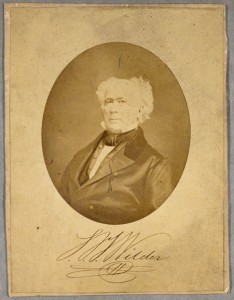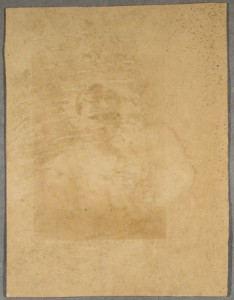These days you would be more likely to encounter a young child e-mailing or texting than writing a letter to a family correspondent. Many believe that letter writing is a lost art in the digital age. It is certainly romanticized in films and books but in the 19th century household correspondence was an excellent tool to teach children not only how to read and write but how to successfully express themselves.
During my internship at AAS I’ve had the opportunity to work closely with the family correspondence of Sampson Vryling Stoddard Wilder, an early 19th century merchant and prolific correspondent. While going through the letters of this collection (most of them are between Sampson and his ex-pastor, Reverend Chickering) I kept coming across delightful tidbits written by Sampson’s children. This got me thinking about the nature of family letter writing and education within the home. Also, they’re just very interesting and I wanted to share them with you!


Sampson’s daughter, Vrylina, is the most present child in the letters. On 23 April 1831 she added her own note at the bottom of her father’s letter to Rev. Chickering:
My dear Mr Chickering
Ma has come home, and I am very glad. I was tired of staying at the Institute. Sampson was very glad to see his sisters again. When I am seven years old, I am going to Bolton, to see you, and your cow, cat, Pigs, and chickens. Give my love to Mrs Chickering.
Good bye. Vrylina
Vrylina’s baby brother, Sampson, is mentioned again in an earlier letter in which she provides this anecdote: “Sampson likes pictures very much he saw Just now a monkey in a book drinking out of a glass, and he said ‘I afraid monkey will break it.’ He is a funny little boy.” I have not had much luck finding information about S.V.S. Wilder’s children so it is unclear to me how old Vrylina and Sampson would have been at this time. These little glimpses into family life, though, are truly treasures.
A letter dated 29 February 1836 is probably the most entertaining and thought provoking of all the juvenile writing I’ve encountered in this collection. Again Vrylina is the author. It is clear from her handwriting and exposition that she has matured. What is really interesting is that she has developed a bit of a sarcastic personality over the years. She writes to Rev. Chickering,
Papa says that there is an excellent opportunity to write to you without any postage, and that we must all write to you, but I told him I had nothing to write, he says, that is no matter, that you like long letters, even if they do not contain anything, so in obedience to Papa, I have made up my mind to fill a sheet, and I promise you in advance, that all, I shall say, will not be worth the ink and paper upon which it is written…
Later in her letter Vrylina asks the pastor to pray for her so “that I may be led to profess the Lord Jesus Christ, and thus be prepared when it shall please the Lord to call me hence to meet the angelick spirits of my dear little brother and sisters.” This request came about because of a worry that her father had expressed to her that she may not be spiritually prepared should she die unexpectedly. What is so fascinating for me here is that this young child speaks of death without fear. It is something that she has had personal experience with and something her parents did not shield her from. It is clear from this example that being compelled to write letters helped children to reflect upon their own lives and even their own spirituality.
In a pamphlet distributed to the trustees of the Philadelphia Academy, Benjamin Franklin highlighted the importance of correspondence, “The boys should be put on writing letters to each other on any common occurrences… imaginary business &c. containing little stories.” The purpose of this training was to teach students to communicate efficiently.
Surely Vrylina and Sampson’s father, Sampson Wilder, is a prime example of a good communicator. In a memorial to him it was said, Wilder’s writing was “terse and direct if occasion required; and seldom repetitious, each additional word being there with a purpose, defining or amplifying the leading idea.” As a man who valued writing and maintained a large correspondence it seems only natural that he would foster the virtue of good writing practices in his children.

Greetings from SVS Wilder 6th Gr Grandson! Fine Research by you.
I would like to connect you to the Ma Lafayette Society. I’m past President.
Mr Wllder and Lafayette were close friends. I know the new owners of the Wilder Mansion.
=
regards, bill…..
Hi Bill,
Thank you for your interest and compliment. I’d love to hear more from you. My internship at AAS is over but I am still present there as a volunteer. You can get in touch with me directly through my e-mail, chelsw88@gmail.com. Thanks again.
Chelsea
Hi Chelsea,
Your article about the Wilder children is fascinating. Over the years I have done quite a bit of research on SVS Wilder, an ancestor of mine, and am currently working on genealogical study of his maternal ancestry.
I have data on the births, marriages, and deaths of his children should you be interested.
Best,
Jonathan